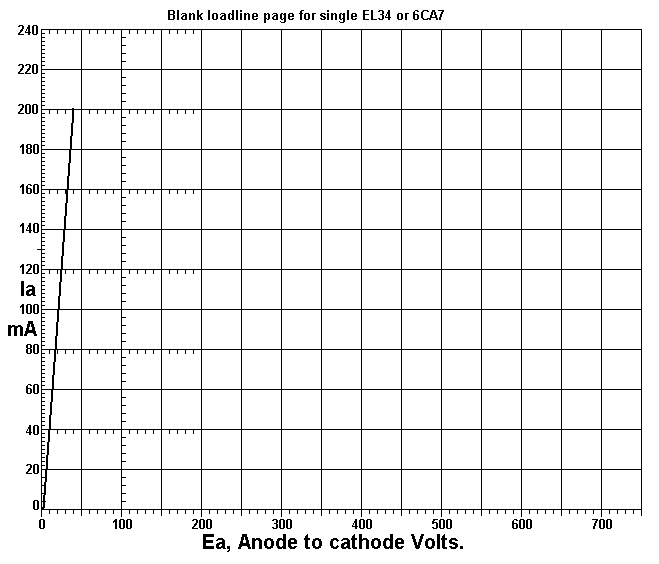SE OPT CALCULATIONS PAGE 3.
(A) About 8W SE amp in old radio, analysis, operation, wave forms.
Fig 1. Schematic of 8W SE amp for Old Radio, to replace dreadful
engineering of 1950.
Notes about various output tubes etc.
Picture 1. 1940s radio chassis completely re-built, and with
speaker made after 1990.
Many things about operation explained.
CRO-1. Dual trace Oscilloscope pictures of signal waves. CRO is
Cathode Ray Oscilloscope.
CRO-2. Dual trace Oscilloscope pictures of signal waves.
Fig 1. Relative dimensions for wasteless pattern E&I
laminations.
CRO-3. Dual trace Oscilloscope pictures of signal waves.
CRO-4. Dual trace Oscilloscope pictures of signal waves.
CRO-5. Dual trace Oscilloscope pictures of signal waves.
Many explanations of distortion shown on CRO.
CRO-6. Dual trace Oscilloscope pictures of signal waves.
CRO-7. Dual trace Oscilloscope pictures of signal waves.
CRO-8. Dual trace Oscilloscope pictures of signal waves.
Many explanations.
(B) Measurements of low power OPT used in old radio.
Steps 1 to 10.
(C) Why would anyone design an OPT for only 8W?
Fig 2. Design details for hi-fi quality 10W SE OPT-5D.
(D) Design for 16W SE OPT-9 for pentodes or beam tetrodes with CFB
or 50% UL.
Steps 1 to 19.
Table 1. Ea x Iadc conditions for 2 x parallel EL34 for SE
pentode, RLa 1k5 to 5k0.
Table 2. Grade 2 winding wire sizes.
Fig 3. Finding Ea and Iadc for 1 x EL34 with RLa = 5k2.
Fig 4. SE OPT-10. 16W for 2k7 : 3r5, 7r9, 14r0, for 2 x EL34,
6CA7, KT66 or 1 x KT120.
Fig 5.SE OPT-9, 16W, 2k7 : 3r3, 7r3, 13r0, for 2 x EL34, 6CA7,
KT66 or 1 x KT120.
(E) HIGH VOLTAGE TESTING.
Fig 6. Schematic for HV tests
Explanations.
Blank graph sheet for plotting loadlines for 2 x EL34.
VOLTAGES IN OLD RADIOS KILL
PEOPLE.
PLEASE USE CARE TO AVOID DEATH !!!!!!!!!!!!
(A) SE amp details for old radio, with schematic and wave forms.
Fig 1. 8W SE output audio amp.
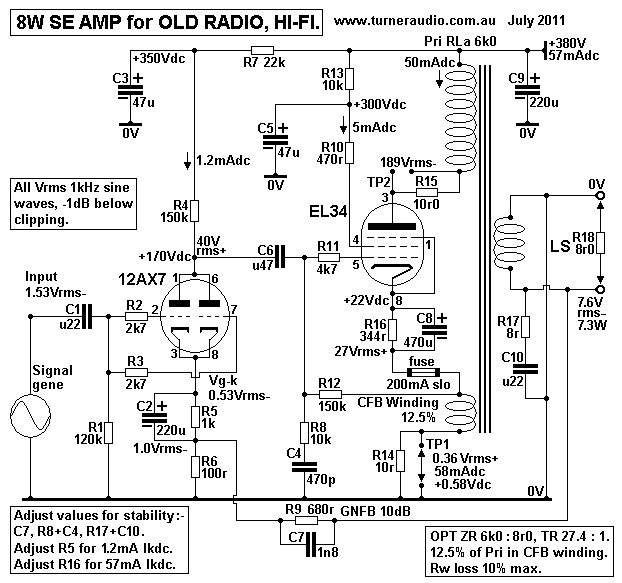
Fig 1 schematic is for the simplest 8W Hi-Fi amp which could be
made.
I've used this basic schematic in many old AM radios to get better
sound than any of
the original amps using 6V6, 6F6, 6BQ5, 6AM5 which made 3W max,
had 100Hz to
8kHz bandwidth, no NFB, and THD = 10% max, with dreadful IMD, plus
noise.
Fig 1 shows a best practice use of OPT with SE+CFB configuration,
and with total
OPT winding loss < 10%. Typical E&I core size was
originally T 25mm tongue x 20mm stack.
I sometimes used T32mm x S32mm for say 6k0 : 8r0, with Np = 3,000t
and Ns = 110t,
Interleaving pattern S-P-S at least, or preferably P-S-P-S-P. RwP
< 300r, RwS < 0.4r
The primary should have between 12% to 15% of primary turns for a
cathode feedback
winding, CFB.
Cathode biasing is best, and the EL34 screen should be to a fixed
Eg2 of at least +270Vdc
above Ek bias Vdc, but lower than Ea between anode and cathode. It
is possible to get
Ea = +350Vdc, and up to 8W of anode Po with Ia = 52mA, and Ig2 =
about 5mA, with
Idle Pda = 17.5W.
Instead of a CFB winding, the next best thing is to have a primary
with CT or other tap
for between 40% to 50% UL operation. EL34 require low Ek with Eg2
lower than Ea.
Use of 6L6GC, KT66 will require higher Ek for the same Ikdc. This
reduces possible Ea-k
which needs to be as high as possible for most old HT windings to
allow a high as possible
Va swing, with low Iadc and to suit the original OPT, if it is
usable, or to suit something
you wind.
The original PT in many old radio sets could make quite high Vac,
but with very low Idc,
because it was always cheaper to go with high voltage with low
current.
The 6L6GC, KT66, 807 will need higher grid Vac than for EL34.
In all ways, EL34 is the best tube but it does need twice the
heater current of 6V6 etc for
its cathode heater. I found that most old radios had heater
windings with large enough wire
to prevent windings overheating if twice the Iac was wanted. A
thin wire fuse link must
ALWAYS be used between heater winding and all heaters. I found a
paralleled 12AX7
was a good input + driver tube for EL34.
In old radios I re-engineered, I always installed a source select
switch and RCA sockets for
CD player or FM tuner.
Picture 1. Completely re-engineered 1935 AM radio chassis.
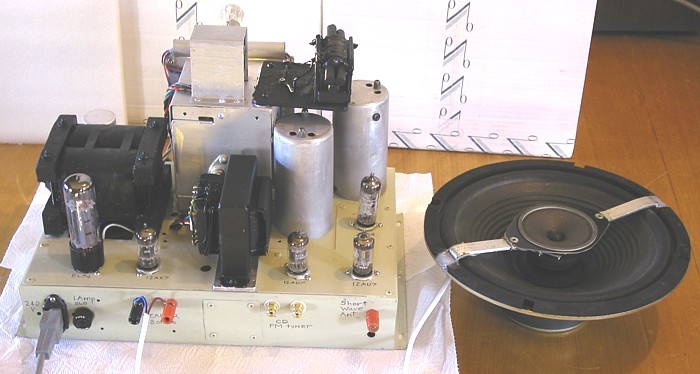
The picture shows rear view of a completely re-engineered 1935 AM
radio chassis
from July 2011. The modern 10" bass-midrange speaker with
concentric HF driver is
shown. There is a mains fuse, IEC mains cable input and grounded
chassis for safety.
There is a replacement PT on left side, with EL34 + 12AX7 audio
amp. There is a new
OPT in the chassis centre. There are RCA terminals provided for
use with FM tuner
or CD player. Sound is mono, but very listenable. The other tubes
used to replace
ancient old European types with uncommon sockets from pre-1940
were 6AN7 mixer,
6N8 IF amp, 12AU7 detector, 12AU7 treble control stage with slight
gain.
These are still available as NOS in 2017.
The OPT has a non-wasteless pattern of old E&I laminations
with Tongue = 25mm,
Stack = 24mm, Window L = 52mm, H = 16.6mm.
ML = 189mm. Np = 3,200 turns of 0.3mm Cu dia wire.
Primary nominal RL = 6,400r. Secondary windings may be
configured to give :-
4 // 81t for 4r1, 3 // 108t for 7r3, 2 // 162t for 16r4.
7r3 sec is used for the "8r0" speaker. The reformed chassis was
for an old floor standing
AM radio where low power operation will be used. The large open
backed cabinet has a
natural cut off at about 60Hz.
There is no point in making an amp which needs to produce full
power at below 50Hz.
The amplifier bandwidth has been tailored to have a cut off at
40Hz. Fsat at max output
level can be allowed to 30Hz.
Anyone could use Fig 1 schematic for a pair of hi-fi amp channels
with a single PSU
all on one chassis for 8+8 amp, which may sound better than having
PP amps with
a pair of 6GW8 or 6BM8, or EL84 in each.
If someone makes their own OPT, The bobbin should be varnished as
it is wound.
But after the core has been placed into bobbin, OPT should be
connected to the
EL34 to test the OPT properties and to set the air gap. The GNFB
can be left disconnected,
but CFB will be used, or UL or triode connection used. There is no
point to use pure
pentode because THD will be > 10% at max Po.
The air gap is initially set to what has been calculated. The
testing will show if air
gap needs to increase of decrease. Yoke bolts may be left loose to
facilitate adding
or removing sheets of paper used to set the air gap size. A dummy
load resistor, say
2 x 15r0 5W parallel should be connected to OPT sec to give
calculated RLa for
maximum Po.
Input test signal from sig gene must have THD > 1% for 5Hz to
100kHz. Initially, use
1kHz to increase Vo at Sec RL to where clipping occurs. Clipping
on + and - wave peaks
should be symmetrical, ie, occur at same +/-Vpk. Vo should be
measured where clipping
just begins to be seen on CRO, Cathode Ray Oscilloscope.
Po is calculated = Vo squared / RL. If you have RL = 7r5, and you
have Vo = 7.5Vrms,
then Po = 7.5W. This indicates your efforts do not include huge
mistakes which are all
too common with DIYers.
A CRO MUST be used to monitor all signal voltage measurements and
distortions at
the output terminals. Input sine waves may 1% THD, but be prepared
to see much
more THD during tests. Ideally, the signal generator has six F
ranges to give 2Hz to 2MHz,
each with flat response for +/-0.5dB max. The dial will be well
calibrated to show all F
within +/- 5% accuracy.
To monitor all tube currents, 10r0 x 5W are placed in series
between anode and primary
winding and between cathode winding and 0V, see TP2 near R15 at
EL34 anode and
TP1 near R14 at bottom of CFB winding. R15 carries only anode
current, and R14 carries
anode current plus screen current, maybe 7% of anode current.
There is some screen
signal current flow so measurements of anode current are most
accurate at TP2.
But anode current waveform distortion is most easily seen at TP1.
Where CFB is used, the THD at onset of clipping should not exceed
2%, and 12.5%
CFB will reduce effective Ra of EL34 to slightly less than triode
Ra. To test parameters
LL and Csh, the OPT is best tested with method in SE OPT calcs 2.
Lp and Fsat and air gap
size will be very well done with OPT in amp with tubes.
With GNFB present, the OPT Vac at sec may appear linear with THD
< 1% at clipping while
the EL34 grid signal appears to have maybe 10% THD because it
contains an opposite
phase of the THD at output, called the "error signal". This
creates tube currents which sum
with distortion currents produced without NFB to give far less THD
than if no GNFB was used.
The very same action occurs with CFB, but is kept local, and
amounts to about 10dB NFB.
Only 10dB GNFB is needed to get The absence of high THD makes it
more reliable to measure
LL and Fsat. But when clipping occurs or Fsat is reached with high
enough Vac levels, the
THD rises exponentially, because during clipped parts of the
waves, the output tube has no
gain in output stage so the error signal much increases and
acts in vain to reduce THD.
The amplifier with GNFB may oscillate at below 20Hz or above 20kHz
if gain shelving and
R+C Zobel networks have not been or have the wrong R&C values
which are needed to suit
the OPT purchased for use, or the OPT which has just been wound.
The amp is most likely to oscillate at LF or HF with no Sec RL
connected. HF oscillations with
no RL are usually totally prevented with R7+C4 and R9+C7. R17+C10
may or may not be
needed. LF stability should be OK because the amp has only 2 tube
stages instead of the
common 3 stages with say 2 halves of 12AU7, 6CG7 etc. The number
of C+R couplings = 1,
and R+L in OPT = 1. If there is LF oscillation, use 1M0+47nF
parallel network between output
of C6 u47, and input of R11 4k7.
If CFB is not used, then with 50% UL tap the GNFB should be 15dB,
with increase of
R6 100r to 150r, and if triode is to be used, increase NFB to 12dB
with R6 100r increased to
120r. ( approximately, so CHECK it out when you do it ).
EL3e in triode gives Ra = 1k3 approx, about 1/5 of anode RLa, so
damping factor DF is about
4 without GNFB and some find this sounds fine. 50% UL gives Ra =
about 2k5, and DF
about 2, so some GNFB is definitely needed.
Below are photos of oscilloscope screen using a 1983 dual trace
15MHz Hitachi oscilloscope ( CRO. )
The images below show typical wave forms common to many tube SE
amps with
Global Negative Feedback, GNFB.
I used an amp with a single Sovtek EL34 set up in SEUL
configuration with 50% UL tap,
and no CFB.
CRO 1.

CRO 1 shows two traces at 1kHz and Top trace is the secondary
output voltage with rated
load at onset of symmetrical clipping. The negative wave crests at
Top wave show clipping
where Va pk swings negative to diode line and with highest Ia of
about 2 x idle Idc.
The the grid has reached 0Vdc, and begins to conduct grid current
which limits any increase
of Va from 12AX7. The positive wave crests at Top wave are where
Va pk swings positive to
Ia cut off with Ia = 0.0mA, and where grid has swung most
negatively, but with no grid current.
The bottom trace shows Ik ac including Iac and Ig2 in R14 in the
Fig 1 schematic.
The distortion peaks on current wave are produced by effect of NFB
making even higher error
signal at grid to try to force the EL34 into producing more
current and force Ea to swing lower.
The Ia is monitored at the cathode and the current peaks produced
by grid current and
screen current peaking because the load voltage shows no such
current peaks. At this point
the coupling cap driving the EL34 is gaining a negative charge
from grid current which tends
to make the tube effectively biased to conduct less idle Idc.
Sustained over drive just above
clipping upsets DC working conditions.
The 0.0dB Reference Vo signal would be set slightly below levels
shown which indicate
THD = 2% approximately.
Measuring primary inductance. The primary inductance should be
measured at the -6dB Vo
level at the lowest frequency easily measured and where THD <
3%.
CRO 2.

CRO 2 top trace is at 25Hz, Vo = -6dB, NO RL. At this Vo level
there is no saturation
and the primary load is only Lp inductive reactance, XLp.
The bottom trace shows the cathode Ik ac including Iac and Ig2
current flows at cathode
in R14 in Fig 1 schematic. There is no severe distortion and EL34
load at the primary is
a fairly linear inductive reactance without saturation effects.
The Va anode to cathode was 100Vrms in this case. This is the
total Vac signal across
all primary windings. If 12.5% CFB windings are used, there would
be 100Vrms between
anode and cathode, with 12.5Vrms between cathode and 0V, and
87.5Vrms between
anode and 0V, and they have opposite phase. But with SEUL, there
is just 100Vrms
between anode and 0V; ( the Vac across R14 is small ) or across
the whole anode
winding from B+ to anode.
In this example Vac across R14 = 0.265Vrms, and so Ia =
0.0265Arms, So Lp reactance,
XLp, at 25Hz = Vac / Iac = 100V / 0.0265A = 3,773r.
Lp = XLp / ( F x 6.28 ) where L is Henry, F is in Hertz, and 6.28
= constant = 2 x pye.
So Lp = 3,773r / ( 25Hz x 6.28 ) = 24H.
Because XLp = 3.8k approx, the Vo wave shows about 2% THD because
of the loading
effect of a reactance approaching 1/2 the ideal RLa value. The
bottom 25Hz current
waveform shows 5% THD because the GNFB is trying to correct the
voltage distortion.
If you examined the EL34 grid signal you might find it had 5% THD
or more, because a
fraction of any THD at the amp output is fed back to V1 12AX7
cathode then amplified so
it appears at V2 EL34 grid with its phase inverted, therefore
trying to reduce the output
THD as it is produced. The above waveforms show that the air gap
would be nearly
optimized. If there was severe THD at say -6dB at say 60Hz, it may
indicate the gap is
far too small or too large or that the OPT being tested may be
unsuitable for the intended
application.
If Lp = 24H, and Nominal RLa = 6k0, then XL = RLa where F = RLa /
( 6.28 x Lp )
= 6,000 / ( 6.28 x 24H ) = 39.8Hz. This means that if tube has RLa
= 6,000r, then total
load at 40Hz = Lp // RLa = 4,242r, and partially reactive. The
inductive load + R load is
less than 6k0 so full 0dB Vo level could not be maintained. At
100Hz, XLp = 15k0, and
this would not have much loading effect. So if max Po levels are
set for 1kHz, and F is
reduced, and THD is limited to < 2%, Vo will be -3dB at 40Hz,
and -6dB at 20Hz.
The lack of Lp reduces the full "power bandwidth"
How to adjust the air gap size for optimum operation.
Fig 1. Relative sizes for wasteless E&I laminations.
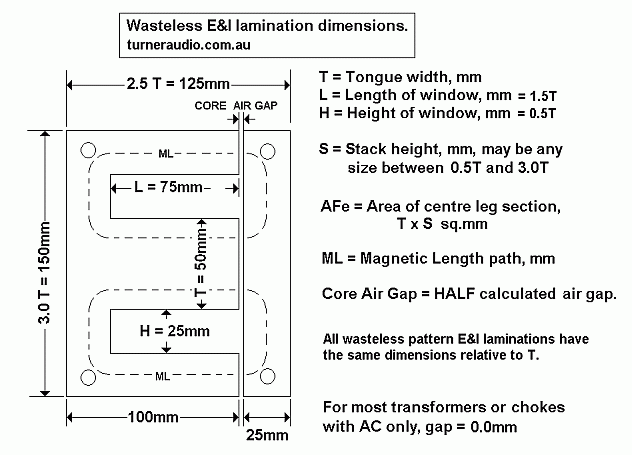
Fig 2 shows wasteless pattern E&I laminations. There are TWO
magnetic paths
around the TWO core windows which act together as ONE magnetic
path.
The Iron magnetic path length, ML = 2H + 2L + ( pye x H ) for any
wasteless E+I core
material. This formula can be simplified to Wasteless Pattern ML =
5.57 x T.
The calculated air gap is initially used for tests, if it was
calculated. The gap material
will be 1/2 the calculated air gap because each ML has a gap on
each side of each
window. If the gap was not calculated or preset, which may be the
case with an old
stock OPT being trialled, adjustment of the air gap must be
possible with Is made loose
to allow gap adjustment. If the OPT is in a pot filled with epoxy
fill, it will be almost
impossible to remove it from pot and adjust the gap without
wrecking the OPT, so then
air gap must be left alone and the tubes and operating conditions
chosen to suit the
OPT properties. If the potted OPT is no good for EL34, perhaps
something else should
be wound or purchased.
Adjusting the air gap.
The yokes and bolts holding Es and Is together must be loosened to
permit air gap
adjustment.
With an "open frame" OPT is used, initial tests are with no gap
between Es and Is.
With loose bolts and yokes, Idc in primary turns makes a strong
magnetic force which
is usually enough to draw the blocks of Es and Is tightly
together, and E&I come as
close as possible.
To set the air gap, there is no sec load on OPT, and the Va is
brought up to the same
level as for max Po at 1kHz with RL. This is the 0.0dB level.
The wanted Idc must flow. The distortion without any load should
be lower than with
Sec RL connected. The frequency is then reduced slowly down and it
should be able
o be reduced to at least 100Hz without any serious increase in
distortion. But as F is
reduced below 100Hz, some THD will inevitably become visible on
the CRO screen.
CRO 3.
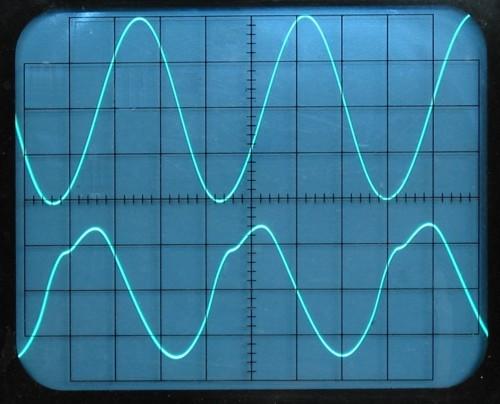
CRO 3 shows top trace is 100Hz, Vo = 0.0dB, with NO RL.
The primary load is Lp inductance = 10H approx at 100Hz. XLp =
6,280r at 100Hz,
so THD is low Va will be slightly less than 0dB level for 1kHz
where XL is higher.
At 25Hz, Lp = about 24H with XLp = 3,768r. Common sense tells us
XLp at 1kHz
should be 150k. But max µe is highest at LF, and declines as F
rises, so µe may
reduce may be 1/6 of 25Hz value, so L at 1kHz may be only 4H, with
XLp = 25,000r.
With OPT RL connected and RLa at 1kHz = 6,400r, the
total L // R load = 1 / sq.rt [ ( 1 / R squared ) + ( 1 x XLp
squared ) ]
1 / sq.rt [ ( 1 / 40.1 ) + ( 1 / 625k ) ] = 6,202r.
As XLp reduces below 100Hz, the 0.0dB Va level cannot be
maintained without THD
increasing because the load value has reduced below 6k4.
For 1kHz, and no RL connected, the Vo wave has low THD because of
the high XLp
value of 25k, and EL34 has more gain with the high load thus
increasing the effective
amount of applied GNFB. The amount of applied NFB = 20 x log (
A / [ 1 + A x ß ] ),
so as the open loop gain A increases, NFB increases.
Open loop gain = gain without GNFB
= gain 12AX7 x gain EL34 x OPT P:S voltage ratio.
The bottom trace shows Ia current waveform has some distortion
because the iron is
beginning to show some non linear behaviour. One may think the
frequency is high
enough to get away from iron distortion, but not with this old
iron in this OPT.
CRO 4.

CRO 4 top trace is 32Hz, Vo = -4dB below 0.0dB, 141Vrms, but where
Lp = 20H,
and XLp = 4k0. NO Sec RL is connected.
Top wave shows primary reactance has begun to become a non linear
reactance
suffering partial magnetic field collapse aka saturation during
part of each wave cycle.
The actual Fsat onset was at approximately 35Hz, with XLp = 4k2,
Va = 141Vrms.
Vo wave has a sudden onset of THD which indicate XLp becomes a
very low resistance
for about 1/10 of each wave cycle. The saturation produces a quite
different shape to
gradual increase of asymmetrical wave clipping when XLp becomes
lower than RLa value.
At 35Hz, Vo must be reduced to -3dB at least to get a linear Vo
wave, although considerable
non linear tube current would exist. The performance of this OPT
is not optimum, despite
average levels of music being 0.8W, where average Va = -10dB below
sine wave
clipping level for 1kHz.
CRO 5.

CRO 5 top trace is 25Hz, Vo = 0dB, NO RL.
The primary reactance has become a very non linear reactance than
in Fig CRO 4.
To avoid distortion in Vo wave, level would have to be reduced to
less than -6dB.
The bottom 25Hz current waveform contains more distortion than at
32Hz.
CR0 3, 4, 5, show waves where core has begun to saturate, limiting
the Vac level
across the OPT primary as F goes lower.
The OPT tested here has serious limitations for hi-fi. But it
worked well for an AM
radio where the sound was far better than what was originally
manufactured.
For hi-fi, a larger OPT core is needed.
The material used for the OPT was old iron, non oriented Si Fe and
if lams a are
fully interleaved the max µ = 2,500. With air gap of 0.25mm, µe =
586. Use of GOSS
would give max µ 5,000, but the air gap would still have to give
µe = about 580.
The distortion may be slightly less, but no matter what is done,
this sample of OPT
tested cannot give low THD at more than 6.2W for 6k4 below about
80Hz where
the XLp = 12k0, and where loading effect of Lp reduces total load
= 5,650r, giving
Va max = 200Vrms.
CRO 6.

CRO 6 top trace is 47Hz, Vo = -6dB, and with secondary RL so PO =
1.85W.
There is no sign of saturation or loading related distortions. The
bottom Ia trace
is also very clean. Within music signals, the bass between 50Hz
and 200Hz may
average 4 times level of anything above 200Hz. This means that one
would not want
bass signals to exceed the -6dB level so there is voltage headroom
for midrange
and treble levels without much clipping.
The secret to getting good sound from any 8W amp is to use
sensitive speakers,
and good load matching. Modern speaker sensitivity may be 90dB/W/M
at 1kHz,
and often much less below 100Hz. People expect less THD / IMD and
higher levels.
The nominal Po of 2.5W typically found from a 6V6 in an old 1950
radio gave 0.25W
with THD > 4%, poor bandwidth. With less THD from detector, and
max 7W from EL34,
there is 0.75W available for louder sound at THD < 1%, with a
better detector.
Listening is believing, and the amount of work to get the
betterment is huge.
Some drivers meant for use in car audio systems or for ceiling
mounting have a small
cone midrange and dome tweeter already concentrically mounted.
These make good
replacements for old original speakers of 200mm dia. Picture
1 shows large 250mm dia
bass with treble unit mounted concentrically to allow use in a
large floor standing cabinet.
These were typically 900mm high, 750mm wide, and 250mm front to
back, and there was
no rear panel, so the bass response was no better than a baffle
board about 1.2Meter dia.
The cab was placed against a wall, and the skirting boards kept it
25mm away from wall
so there was no bass reflex action to increase the bass below
100Hz. The speaker must
be obtained before the OPT is wound to ensure the OPT has the
right turn ratio and
impedance ratio.
CRO 7.

CRO 7 top trace is at 20Hz, Vo = -6dB, with NO RL. The load on the
EL34 output tube
is a mainly linear inductive reactance of 24H. The reactance of
24H at 20Hz = 3k0,
less than 1/2 the rated load of 6k4, so hence one can see
approximately 3% THD
caused by the low value inductive load at LF.
The bottom trace for Ia shows THD at about 7%. The loop of GNFB is
not succeeding
to reduce the voltage distortion very much.
But because little music content occurs at 20Hz, the sound will
remain OK.
CRO 8.
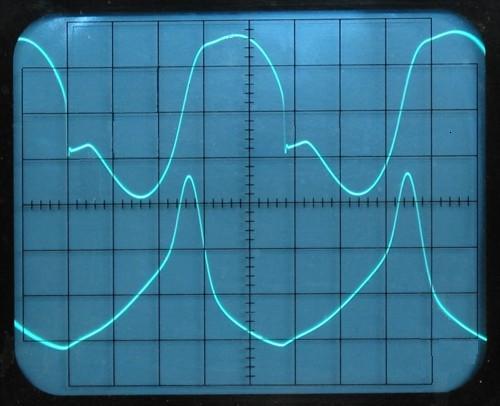
CRO 8 top trace is at 16Hz, has Vo = -6dB, with NO RL. The load on
the EL34
output tube has become a non linear inductive reactance of 24H and
saturation
is occurring. In fact the onset of saturation at -6dB is about
17Hz, and half the Fsat
for the 0dB Vo level. This shows shows saturation to be a voltage
caused phenomena
with no relation to the RL load used.
The EL34 is struggling with the low value inductive load which at
16Hz = 2k4.
If the Vo was inspected at the -12dB level, and at 8Hz, RL would
be 1k2, and
saturation would have just begun. The bottom trace for Ia shows
THD at about 15%.
The loop of GNFB is not succeeding to reduce the THD at Vo.
Conclusions for this example for 1 x EL34, SEUL.
For better performance, increasing core stack to 50mm while
leaving all turns and
interleaving the same would double Lp and allow lower F = 22Hz for
where XLp = 6k4.
Bac would be halved, lowering Fsat to say 24Hz. The air gap may
remain the same
for the same µe.
With no gap at all, will all Es hard against all Is, the Fsat for
onset of saturation and
high THD of Vo wave at Sec maybe not much below 100Hz because µe
may be well
above what is wanted for optimum performance, so Bdc is high, so
Bac cannot be high
without saturation, or the core is saturated without any Vac
applied.
Without using a better OPT, ie, with bigger Afe, the only cure to
extend LF performance
with the radio OPT is to use a choke with bigger size than OPT but
with 7,000t to feed
Idc to EL34 anode. This can be made to have L = 100H at 50mAdc.
The OPT is dismantled, and all E+I are fully intermeshed which
will increase µ of say
586 to 2,500, so Lp max = 100H. There is no Idc in OPT, so Bac can
double, so Fsat
occurs below 25Hz. The OPT has its B+ terminal connected to 0V and
its anode terminal
coupled to anode via 100uF electrolytic C.
The total L below 30Hz = 50H, so XL = 6,400r at 20Hz, low enough.
The use of choke feed is an excessive amount of work and it makes
more sense to just
start with a much larger OPT, unless a good cheap Push-Pull 10W
OPT meant for
6k4 : 4r0-8r0-16r0 is found, and then making or buying a 100H
choke may be easy.
The last time I looked for 16W OPTs in about 2004 there were only
25W or 30W types
available from Hammond.
I used a pair here 4+4-set-stereo-2a3.html
These are available with 5k0 primary and
the same 4.5Kg, massive for 4W from 2A3.
The same size OPT can be used for 845, 211 and 2 x 300B or 2 x
EL34, 6550, KT88 etc.
Now, in 2017, Sowter in UK also make something just as large, but
cost and freight are
an issue. Edcore also make something made to order, but I have
never seen any.
I have SE OPT details for a single EL34, 6CA7, KT66, 6550, KT88,
KT90, KT120 at
se-output-trans-calc-1.html
For gap material, ordinary paper from a normal exercize book will
be fine. But you need
to know the paper thickness. My 128 page exercise book has 64
sheets and stack of paper
excluding cardboard covers = 5mm. Therefore each sheet = 5mm / 64
= 0.078mm.
The use of paper is a convenient way to adjust an air gap.
For a true hi-fi 8W SE OPT, See Table 8 in se-output-trans-calc-2.html
Look at 38mm x 38mm core with Afe = 1,444sq.mm
This core Afe size is about 3 times the size ever seen in most SE
amps in any old radios
or radio grams with 6V6 or EL84 making maybe 5W maximum at anode
and giving
3.5W at speaker.
But to obey all the rules for hi-fi mentioned at this website,
there should be more iron / W
than was ever commonly used in most OPTs. What I have described
here is acceptable
for the intended low level use only. I demonstrate how to set air
gaps to maintain a high
enough RLa value for the anode load down to low enough bass
frequencies and without
core saturation for most music.
Therefore Fsat at 42Hz is OK for an old radio, but for a hi-fi
amp, Fsat should be < 20Hz
at near full Po.
-----------------------------------------------------------------------------------------------------------
(B) Calculations for Old Radio SE OPT used above :-
NOSS E+I Core, T25mm x S24mm, Window L52mm x H16.6mm. Np = 3,200t,
0.3mm Cu dia.
ML = TL = 138mm.
Primary nominal RL = 6,400r. Secondary windings may be configured
to give :-
4 // 81t for 4r1, 3 // 108t for 7r3, 2 // 162t for 16r4.
RwP = 121r, RwP loss = 1.9%. Ns = 3 // 108t x 0.5Cu dia, RwS =
0.45r,
RwS loss = 5.4% for RL 8r0.
Total RwP+S loss = 7.3%.
1kHz Sec Po = 7.3W to 8r0 = 7.64Vrms.
1kHz Anode Po max = 8.2W, RLa + RwP+S at Pri = 6,860r, Va =
237Vrms, Ia = 35mArms,
Iadc = 50mAdc.
1. Measure XLp at -6dBVo level, 50Hz. XLp = Vac across Lp / Iac in
Lp.
Lp = XLp / ( 6.28 x F ). For this OPT, Lp at 25Hz = 24H.
2. Calculate µe = 1,000,000,000 x Lp x ML / ( 1,26 x Np squared x
Afe )
= 1,000,000,000 x 24H x 189mm / ( 1.26 x 3,200t x 3,200t x 25mm x
24mm ) = 586.
3. Calculate Bdc = 12.6 x µe x Np x Idc / ( ML x 10,000 )
= 12.6 x 586 x 3,200t x 0.05Adc / ( 138mm x 10,000 ) = 0.85Tesla.
4. Calculate F where XLp = 6,400r? F = 6,400r / ( 6.28 x 24H ) =
43Hz.
This assumes Lp remains constant between 25Hz and 43Hz.
Max Va at 0dB = 237Vrms, max Iac = 237Vac / 6,860r = 0.0353A.
5. Calculate total RLa // XLp at 43Hz = 0.7071 x 6,400r = 4,525r.
6. Calculate max Va where XLp = Rla = 4,525r x 0.0353Arms =
160Vrms. Po = 4W.
7. Calculate Bac at 43Hz = 22.6 x 160V x 10,000 / 25mm x 24mm x
43Hz x 3,200t =
0.43Tesla
8. Calculate total Bdc + Bac at 43Hz = 0.85T + 0.43T = 1.25Tesla,
core is close to
saturation.
9. Calculate air gap using estimate of maximum µ for OPT material
= 2,500 for
maximum intermeshed laminations. But with E&I butted with no
air gap,
max µ = 1,000 approx. Calculated µe = 586.
Air gap = ML x ( µ - µe ) / ( µ x µe ) = 189mm x ( 1,000 -
586 ) / ( 1,000 x 586 )
= 0.133mm.
Calculate air gap material thickness for 2 gaps in ML path,
= Air Gap / 2 = 0.065mm gap material across the two magnetic gaps.
10. Conclusions. The 8W old radio OPT is OK for higher Po than 6V6
or 6BQ5
could deliver but high power bandwidth is from 50Hz to 30kHz.
It is OK at 2W which covers most levels used.
Triode SE amps.
I have an EL34 strapped as a triode in my own kitchen AM radio.
It uses 12AX7
as input / driver and had 12dB GNFB. The OPT was from a 1960 tape
recorder/player
which had 6BQ5 in pentode mode for 4W. The change to EL34 triode
used the same
RLa as for 6BQ5, but with Ea higher to achieve the same Po, but
with much better hi-fi.
Triode RLa = ( Ea / Iadc ) - ( 2 x Ra at Eg1 0V ).
Therefore Ea / Ia = RLa + ( 2 x Ra at Eg1 0V ).
The maximum Pda+Pdg2 for EL34 triode should be 18W, so if max
class A efficiency
= 33%, then expect Po max = 6W. If RLa = 6,400r, for 6W Va =
196Vrms,
and Iac = 31mArms, and Iadc = 43.3mAdc. If Pda = 18W, Ea = 18W /
0.0433A = 416Vdc.
A 6550 with idle Pda+Pdg2 = 24W would give 33% efficiency, and 8W
for 226Vrms to
6,400r and Iadc = 0.052A, Ea = 24 / 0.052A = 461Vdc. Ek for
cathode bias = 58Vdc,
plus there is say 20Vdc drop across OPT Primary and in CRC B+
filter so total B+ after
Si diodes = +539Vdc, so HT winding must be 400Vac. Few existing
PTs in an old radio
have been designed give enough power to allow a 6550 or KT88 etc.
These also require
1.8A x 6.3Vac for heating, more than all the the other tubes in
the radio.
The 6W into 6,400r with triode will sound just as good as for 8W
SEUL, and max SPL is
only 1dB less. The triode does not need screen tap on OPT for SEUL
connection and
often the same OPT used for 6BQ5 or 6V6 can be used with EL34.
----------------------------------------------------------------------------------------------------------------
(C) Why would anyone design an OPT for only 8W?
The 8W design aim can only please those wanting to use only 1 x
EL34, KT66, 6L6GC for
SEUL, beam tetrode, pentode, triode, or CFB. It will not suit
using 1 x 6550 or KT88 unless
the same low Ea and Ia conditions are used.
It is a better idea to design for 16W. This will suit 2 x EL34,
KT66, 6L6GC, 6550, KT88, 300B.
It is possible to have 2 x 2A3, 2 x 300B, 2 x EL34, or 3 / 4 x
6BQ5 providing enough sec load
matches are available to give a wide range of RLa between say 3k0
to 12k0.
I found almost nobody is selling ready made 16W SE OPT. But Edcore
in USA offers to make
them to order. If I ordered from them to suit 1 x EL34, I would
order for 16W, and specify
6k0 : 4r0, 8r0, 16r0, if the multiple sec loads are possible from
them. 1 x EL34 cannot give
16W for 6k0, Va = 310Vrms. But 1 x EL34 can give 9W at anode, Va =
232 Vrms.
It is highly probable Edcore make their SE OPTs for Fsat at max Po
at say 30Hz, ie, where
Va = 310Vrms at 30Hz. The EL34 makes only 232Vrms, but Fsat will
be at 22Hz, and this
is acceptable for most people.
So when ordering an SE OPT for hi-fi performance, the RLa MUST be
known, the makers
standard Fsat known and then OPT is ordered for higher Po is
ordered for that RLa.
I don't much like the Universal 125SE available from
www.hammondmfg.com for less
than 10W.
There are examples of 10W and 12.7W SE OPT at se-output-trans-calc-1.html
For 12.7W, see OPT-5A, OPT-5B, OPT-5C.
For 10.0W, see OPT-5D.
Fig 2. OPT-5D. 10W for 5k0 : 3r5, 7r9, 14r1, and "small"
E+I core.

------------------------------------------------------------------------------------------------------------------------------
(D) Design for 16W SE OPT-10 for pentodes or beam tetrodes with
CFB or 35% - 50% UL.
1. Chose tubes to be used, 2 x KT66, 6L6GC, 807, 6550,
KT88, or 1 x KT120 or KT150.
For 16W max from 2 x EL34 parallel, idle Pda varies between 2.3 x
anode Po
to 2.1 x anode Po. This allows diode line Rd = 150r for 1 x EL34,
so 75r for 2 x EL34.
The highest idle Pda is for lowest Ea expected at 245Vdc, and each
EL34 idle
Pda = 18.4W, and this is well below max Pda 25W.
Table 1. Ea x Iadc conditions for 2 x parallel EL34 for SE
pentode, RLa 1k5 to 5k0.
Tube type
|
Idle Ea-k
|
Idle mAdc
|
RLa
|
Idle Pda
|
Rd
|
Anode Po
|
Sec Po
|
| 2 x EL34 |
245
|
150
|
1k5
|
36.8W
|
75r
|
17.5W
|
16.0W
|
2 x EL34
|
277
|
132
|
2k0
|
36.5W
|
75r
|
17.5W |
16.0W |
2 x EL34
|
303
|
119
|
2k5
|
36.0W
|
75r |
17.5W |
16.0W |
2 x EL34
|
330
|
108
|
3k0
|
35.6W
|
75r
|
17.5W |
16.0W
|
2 x EL34
|
355
|
99
|
3k5
|
35.1W
|
75r |
17.5W |
16.0W |
| 2 x EL34 |
380
|
90
|
4k0
|
34.5W
|
75r |
17.5W |
16.0W |
| 2 x EL34 |
395
|
86
|
4k5
|
34.0W
|
75r |
17.5W |
16.0W |
2 x EL34
|
410
|
82
|
5k0
|
33.6W
|
75r
|
17.5W |
16.0W
|
This information saves everyone the large amount of
incomprehensible mathematics
required to get the Ea and Iadc conditions needed for 2 x EL34 to
make 16W.
2 x KT66, 6L6GC, 807, 6550, KT88 could also give almost identical
results if
Ea and Iadc are same. KT120 or KT150 are the only octal beam
tetrodes capable
of having reliable idle Pda max = 37W so that one tube makes 16W.
The use of 1 x 6550, KT88, KT90 can give less than 16W, but more
than 1 x EL34,
and there is no reason why OPT-9 could not be used for 1 x KT88
with idle Pda = 27W,
to get about 12W, with lower Ea and Iadc to suit one of the load
values shown.
But to get this correct, those dreadful bamboozling mathematics
will have to be
employed, and I make no apologies, and I have not time to provide
millions of
constructors with tables for each one of them to overcome their
inability to think.
For OPT-9, let RLa = 3k0. Each EL34 has RLa = 6k0 including 10%
winding loss.
Ea = 330Vdc x 2 x 54mAdc. Use 2 x EL34, each with idle
Pda = 17.8W, so tubes runs cool.
The RLa of 3,000r includes RwP+S + ZR x Sec RL.
2. Va for 17.5W for 3k0 =
sq.rt ( 17.5W x 3,000r ) = 229Vrms.
Iac
= 76.3mArms, Idc = 108mAdc.
3. Afe = 450 x sq.rt Po = 450 x sq.rt 17.5 = 1,882sq.mm.
Theoretical T for square core section = sq.rt th Afe = 43.4mm
TRY T44mm x S44mm? Afe = 1,936sq.mm, L 66mm, H22mm.
This agrees with T44mmx S44mm core at Table 8, at se-output-trans-calc-2.html
But T44mm material is harder to get than T38mm.
From Table 8,
TRY T38mm x S63mm, Afe = 2,394sq.mm, L57mm, H19mm
4. Theoretical Np for Fsat at 14Hz, with Bac max =
0.7Tesla,
th Np = 229Vrms x 226,000 / ( 2,394sq.mm x 14Hz x 0.7Tesla ) =
2,205turns.
5. Theoretical Pri wire oa dia size = sq.rt ( 0.28 x 57mm
x 19mm / th Np )
= sq.rt ( 303 / 2,205 ) = 0.370mm.
From Table 2, Pri wire size = 0.315mm Cu dia for 0.371mm oa dia.
Table 2. Grade 2 winding wire sizes.
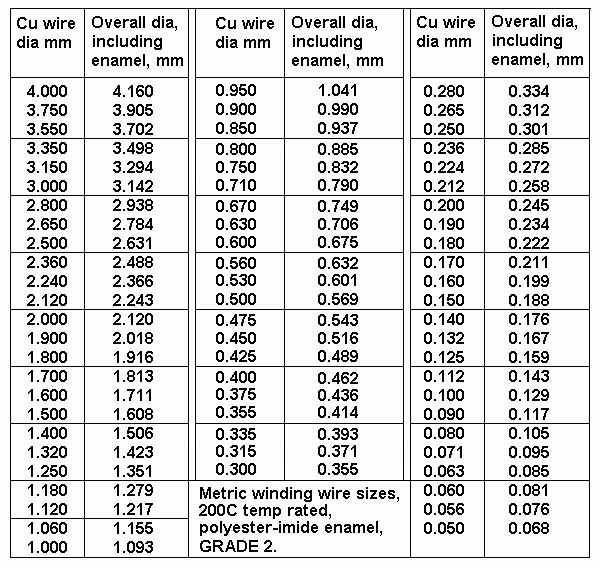
6. Pri tpl = 0.97 x bobbin winding width / oa dia wire =
0.97 x 52mm / 0.371mm
= 136tpl.
7. No Pri layers = th Np / th tpl = 2,205t / 136t = 16.2
layers. So use 16.0 layers.
Thus real Np = 16.0L x 136t = 2,176t.
8. RwP winding loss %. Average TL = 262mm.
RwP = Np x TL / ( 44,000 x Cu dia squared )
= 2,176t x 262mm / ( 44,000 x 0.315mm squared ) = 131r.
RwP loss = 100% x 131 / 3,000r = 4.3%, OK.
9. Choose interleaving pattern = 4S + 3P sections.
2 x EL34 pentodes, pattern = S - 5p - S - 6p - S - 5p - S.
10. Choose CFB %. Try 3 Pri layers for CFB. 3L / 16L =
18.75% CFB = OK.
Use one layer of each Pri section for CFB.
Layer pattern will be S - k - 4p - S - k - 5p - S - 4p - k - S
p = layer of anode winding at B+ Vdc.
k = layer of cathode winding at 0V.
11. Bobbin content heights.
Primary including CFB layers = 16 x 0.371mm = 5.936mm.
0.38mm Nomex 401 insulation between S-k, k-p, p-S, 9 x 0.38mm =
3.42mm.
0.38mm cover over all = 0.38mm.
0.05mm insulation between p layers with same +Vdc = 10 x 0.05mm
= 0.50mm.
Sub total Pri height + all insulation = 10.236mm.
Allowed height of bobbin content = 0.8 x H = 0.8 x 19mm =
15.2mm.
Height available for Sec wire = 15.2mm - 10.236mm = 4.964mm.
12. Secondary windings.
There are 4 Secondary sections. Max height each = 4,964mm / 4 =
1.241mm.
Try one layer of wire, Wire table says max size = 1.12mm Cu dia
x 1.217mm oa dia.
Sec tpl = 52mm / 1.217mm = 42tpl. 4 nearest higher
numbers divisible by 3 =
45t, 48t, 51t, 54t.
NOTE. It is unknown now exactly what loads are available from 5
possible wire sizes.
The total anode load = 3k0, and if total winding losses = 10%,
then the total
RwP+S measured at Primary = 3k0 / 10 = 300r, and ZR x Sec RL =
3,000r - 300r = 2,700r.
Total Rw loss is always = 100% x RwT / [ RwT + ( ZR x Sec RL )
].
So If RwT = 333r, loss = 100% x 300r / [ 300r + 2,700r ] = 10%.
13. Wanted load matches with Np = 2,176t :-
Pri RL = 2,700r, want 4r0, ZR = 675 : 1. TR = 25.98 : 1.
Sec turns needed = 2,176t / 25.98 = 83.76t. Round up to 84t.
Just by chance, the largest wire size gives 42tpl, and there are
4 layers = 168t total.
Thus 2 // ( 42t+42t ) = Ns 84t = 4.024r,
and 42t + ( 42t // 42t ) + 42t = Ns 126t = 9.05r,
and all 42t series = Ns 168t = 16.08r.
The Sec matches are a bit high and if Sec has 39tpl with turns
slightly spread you get
78t = 3.47r, 117t = 7,81r, 156t = 13.88r.
But the better method is to stay with 2,176t : 84t, 26t, 168t
with full Sec layers
and simply change the anode load and revise the Ea + Iadc
conditions to suit the
new RLa value.
If the Sec loads were reduced to 3.5r, 7.8r, 14r, the Pri
load becomes 2,348r, not
including total RwP+S at Pri = 260r which gives total RLa =
2,608r, assuming Rw
losses total 10%.
Therefore total RLa for each EL34 = 5,200r.
Fig 3. Finding Ea and Iadc for 1 x EL34 with RLa = 5k2.
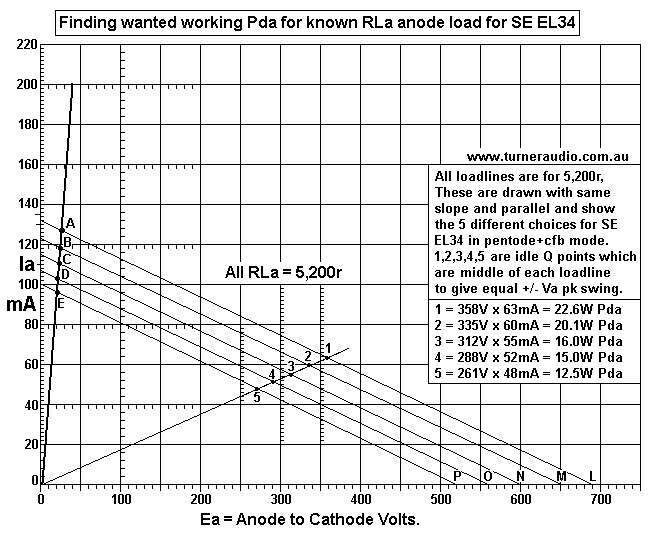
Fig 3 shows the diode line curve on left side and 5 load lines,
all 5,200r. These were all drawn
from 5 calculations of Ea / 5,200r, so that the middle of the
lines was the idle Ea and Iadc which
were not known.
Consider line A-L. For Ea = 690V, chosen randomly, the load line
of 5,200r has Ia change
= 690 / 5,200r = 132.7mA.
Line A-L begins at 690V on Ea axis and passes through A on diode
line and on through Ia axis
at 132.7mA. Now the distance between A and L was measured with a
ruler and Point 1 was
plotted 1/2 way along the line, so A-1 = 1-L.
Other RLa lines were drawn from 650V, 600V, 560V, 520V, and a line from 1 to 0.0 was drawn.
Points 2,3,4,5 were plotted and each gives an idle Ea and Iadc
position which gives maximum
Po for each idle Po. For example, 1 is at 358V x 63mAdc and Pda
= 22.6W, and if anode
efficiency was 45%, you get anode Po = 10.17W, and Va would be
230Vrms. You might get 9W
at Sec so 18W from 2 x EL34.
But for 16W at sec from 2 x EL34, 8W is wanted at Sec from 1 x
EL34.
8.8W is wanted at Pri so Pda = anode Po / Efficiency factor =
8.8W / 0.45= 19.55W, so the
nearest higher idle condition is for 20.1W and Ea 335V x
60mA.
Va = 214Vrms.
The reduction of Va from 229Vrms to 214Vrms gives lower Fsat =
214V x 226,000 / ( 38mm x 63mm x 2,176t x 0.7Tesla ) =
13.3Hz.
For 2 x EL34, RLa = 3,600r, Va 214Vrms,
lac = 82.3mA, minimum Iadc = 117mAdc, use 120madc.
Note. I tried to think of other Sec linking patterns but all
seemed to give no better outcome.
There is a solution for Tapped Sec for 7r7 and 3r9, but that can
wait until design for linked sec is
done.
14. RwS for 3.5r at Sec.
Ns = 2 // ( 42t+42t ). RwS = 84t x 262mm / ( 44,000 x 2 x 1.12mm
x 1.12mm = 0.199r,
Sec Rw loss % for Sec RL = 3.5r0 = 100% x 0.199 / ( 0.199 +
3.50r ) = 5.4%.
RwS appears at Pr as ZR x RwS = 671x 0.20r = 134r.
15. Total RwP+S loss%.
Total RwP + RwS at Pri = 131r + 134r = 265r. Pri RL excluding Rw
= ZR x Sec RL = 3.5r x 671
= 2348r, and total RwP+S loss = 100% x 265r / ( 265r + 2,348r )
= 10.1%. OK.
16. Required µe for Bdc = 0.7Tesla.
µe = Bdc x 10,000 x MLmm / ( 12.6 x Np x Idc )
= 0.7T x 10,000 x 212mm / ( 12.6 x 2,176 x 0.120Adc ) = 451.
17. Lp with µe = 451.
Lp = 1.26 x 2.176 squared x 3,213sqmm x 451 / ( 1,000 x 212mm )
= 40.78H.
18. F for where XL = Total RLa = 2,600r / ( 6.28 x 40.8H
) = 10.15Hz = OK.
Conclusion?
Above, Fsat = 13.3Hz, and XLp = RLa at 10.1Hz. This tells me the
core Afe
may be reduced by smaller stack = 51mm, while keeping Np and Ns
and wire dia the same.
The results are as follows :-
A. TL is reduced from 262mm to 238mm, and Total RwP+S at Pri =
240r and losses
are reduced to 9.3%. Its not much, but is worth
having.
B. Lp is reduced to 40.8H x 51mm / 63mm = 33H and XLp =
2,600r at 12.5Hz = OK.
C. Bdc remains constant and µe remains at 451.
D. Fsat is increased to 13.3Hz x 63mm / 51mm = 16.4Hz.
C. Fsat is only slightly above F for XLp = 2,600r.
D. Because both these F are below 20Hz, the OPT should work just
fine.
E. Therefore Core can be T38mm x S51mm
19. Air gap.
Max µ for GOSS E+I lams maximally intermeshed may be 10,000.
µe with close butted E+I without real gap = 1,500.
Air gap Ag = iron ML x [ 1 - ( µe / µ ) ] / µe = 212mm x
[ 1 - ( 451 / 1,500) ] / 451 = 0.33mm.
Air gap material for 2 gaps around each window = 0.165mm.
Fig 4. SE OPT-10. 16W for 2k7 : 3r5, 7r9, 14r0, for 2 x
EL34, 6CA7, KT66 or 1 x KT120.
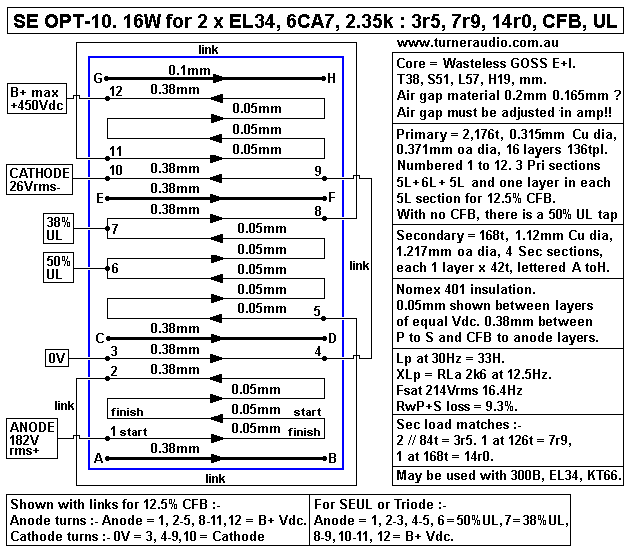
Fig 3 shows all details for OPT-10 for 16W all calculated above.
-------------------------------------------------------------------------------------------------------------------
Fig 5. SE OPT-9, 16W, 2k7 : 3r3, 7r3, 13r0, for 2 x EL34,
6CA7, KT66 or 1 x KT120.
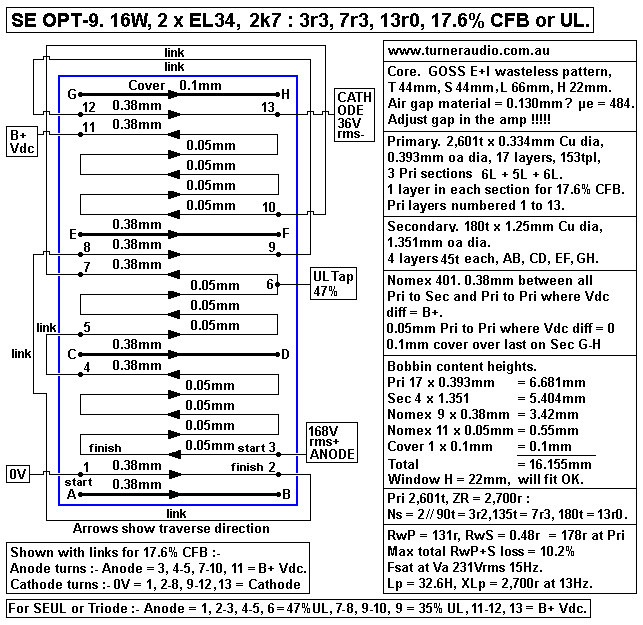
OPT-9 was calculated in an earlier version of this page, and I
then realised T44mm
core E+I material is rare, ( unobtanium ) so I worked out the
details for T38mm instead.
------------------------------------------------------------------------------------------------------------------
(E) HIGH VOLTAGE TESTING.
The OPT should survive HV testing for +4,000V for less than 1
minute without the
OPT having been varnished. But if varnish is generously painted on
to all meeting
surfaces of wire and insulation as it is wound, then the winding
should sustain
+4,000Vdc applied to Primary for 1 minute with all sec windings
and core at 0V.
If an arc does occur after a minute, serious damage is avoided by
having 9 x 1M0
series resistors which limits Idc to 0.44mAdc.
Fig 6. Schematic for HV tests

Fig 23 shows a schematic for applying approximately +3,920Vdc to
the
primary of a transformer under test via 9 x 1M 2W metal film
resistors.
WARNING. HIGH VOLTAGES KILL
PEOPLE !
USE CARE TO AVOID DEATH !!!!!!!
The rectifier is built with a "ladder network" to step up the
200Vac from an
old surplus transformer secondary using 0.1uF caps rated for 630V
and 1N4007 diodes.
Use of higher Vac from a transformer is NO GOOD because max Vdc
across C can
exceed 630Vdc rating. But if enough C rated for higher Vdc can be
found, then higher
Vac and less "ladder steps" need to be used. The core and
secondary is connected to a
10k0 x 5W resistance which is taken 0V of the power supply which
MUST be also
grounded directly to the green and yellow Earth wire from the wall
power outlet.
A Vdc voltmeter is connected across the 10k0 resistance.
When power is turned on
and voltage is raised slowly to maximum, the volt meter should not
show any voltage
across the 10k resistance. But if an arc does occur, there will be
about +4,000Vdc
across 9 Megohms and Idc = 0.44mA. This small Idc current will
flow through the
10k0 and produce a reading of 4.4Vdc. This is the maximum current
flow, and indicates a
short circuit somewhere between primary and anything at earth
potential. If arcs occur,
they may be intermittent and pulses will be seen on the meter. If
a constant Vdc is seen
across the 10k0, there is a short circuit from primary wire to sec
and OPT will need to be
rewound.
No damage or smoke should occur to anything during testing. The
meter used for the
measurement may be a normal cheap analog type. Arcs may pulse, and
digital meters
may not give read out numbers which can be understood.
Back to
SE OPT calcs Page 2
SE OPT calcs Page 1
Index Page
Blank graph sheet for plotting load lines for 1 x EL34, 6CA7,
6L6GC, KT66.
Print a few for ruler and pencil, or copy and past to MS paint for
drawing load lines.
I find MSPaint for XP best, but it crashes in Windows 10, unless
care is taken to
manually save often.
The steeply sloped line on left side is the diode line for EL34,
about 200r.
